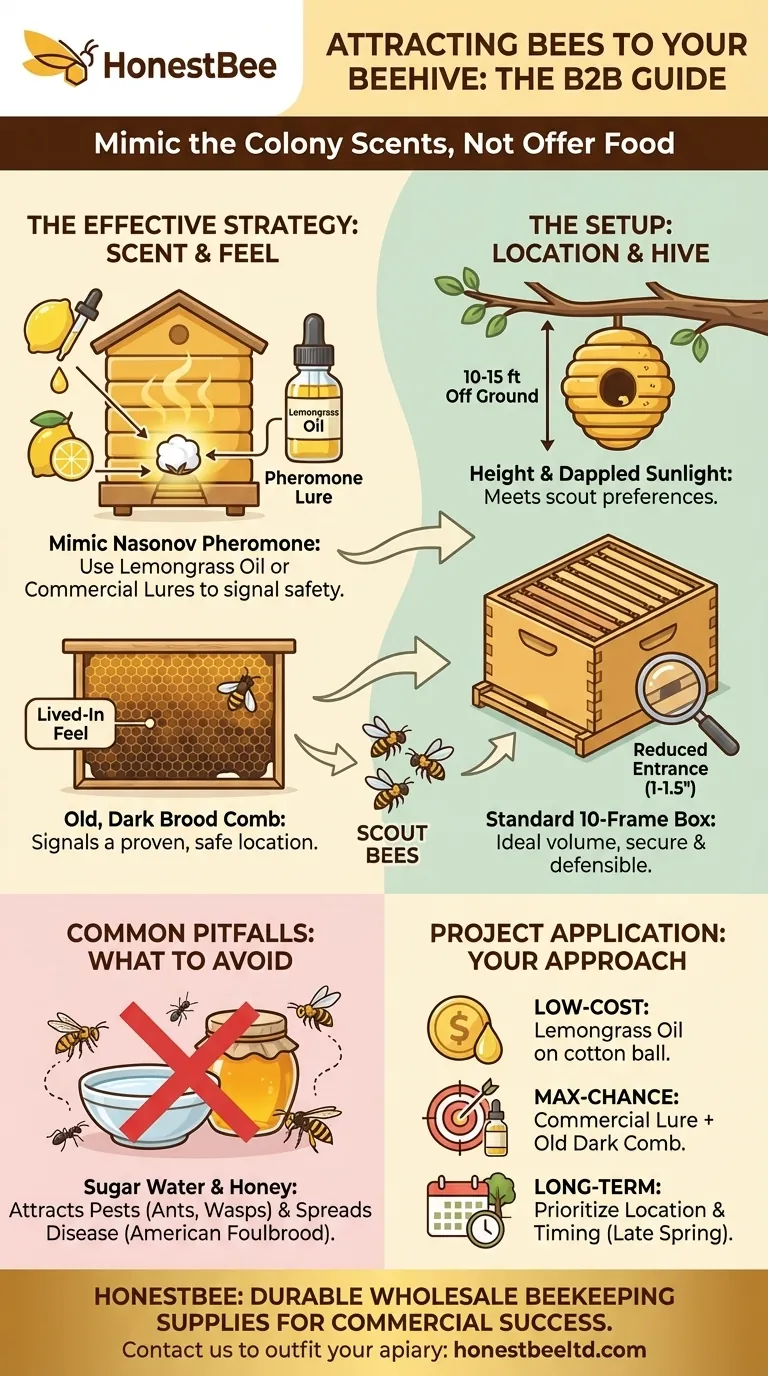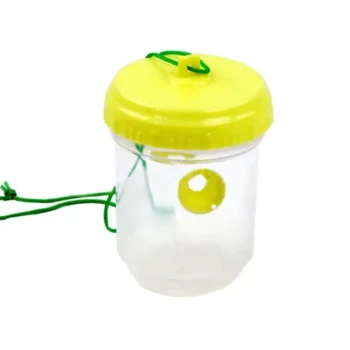The most effective way to attract bees to a new beehive is not by using sugar water, but by mimicking the scent of an established colony. This is done by using specific pheromone lures or a few drops of pure lemongrass essential oil placed inside the hive. This strategy targets the natural house-hunting behavior of scout bees from a swarm.
Your goal is not to offer food, but to convince scout bees that your empty hive is the safest and most desirable new home available. Success depends on tricking their senses into believing other bees have already lived there successfully.

Understanding What Scout Bees Are Looking For
When a honeybee colony becomes too large, it splits through a process called swarming. The old queen and about half the bees leave to find a new home, while a new queen is raised in the original hive. This swarm temporarily clusters on a nearby branch while a small group of experienced scout bees searches for a suitable new cavity.
Your task is to make your "bait hive" (or trap) the most appealing option these scouts find.
The Power of Scent: Pheromones
Scout bees are primarily guided by scent. The most important signal is the Nasonov pheromone, which worker bees release to orient other bees to the entrance of their home. It essentially says, "This is a safe and correct place to be."
You can mimic this scent with lemongrass essential oil, as it shares several of the same chemical components. A few drops on a cotton ball inside the hive are all that is needed. Alternatively, you can use commercial swarm lures, which are specifically formulated pheromone vials designed for this purpose.
The Value of a "Lived-In" Feel
A cavity that smells like it has already housed bees is a powerful attractant. It signals to scouts that the location is safe and has been vetted.
The best way to achieve this is by using old, dark brood comb in one or two of the frames in your bait hive. The scent of old wax, propolis, and past generations of bees is an almost irresistible signal to house-hunting scouts.
Setting Up Your Bait Hive Correctly
How and where you place your hive is just as important as the lure you use inside it.
Location is Everything
Scout bees have specific preferences. For the highest chance of success, place your bait hive 10-15 feet off the ground, ideally in a tree with dappled sunlight. It should be visible but not completely exposed. Proximity to a water source is also a plus.
The Right Hive Configuration
The internal setup matters. Use a standard 10-frame deep Langstroth box, as this volume is ideal for a new swarm.
Ensure the hive has a reduced entrance (about 1 to 1.5 inches wide) to make it feel secure and defensible. Inside, provide 8-10 frames, ideally with at least one or two frames of old, dark comb and the rest with new foundation.
Common Pitfalls and Why to Avoid Them
Many beginners make critical mistakes that actively repel bees or endanger their future colony. Understanding these is vital.
The Danger of Sugar Water and Honey
Using sugar water or honey as a bait is a common but dangerous piece of advice. It does not attract swarms; it attracts pests.
Openly feeding sugar water will quickly draw ants, wasps, and hornets, which will deter scout bees and may even infest your equipment. Using honey from another hive is even worse, as it can carry devastating diseases like American Foulbrood spores, which can remain viable for decades and will infect your new colony.
Poor Timing and Impatience
Swarming is a seasonal event, typically occurring in late spring and early summer. Setting up a bait hive outside of this "swarm season" is unlikely to yield results. Beekeeping requires patience; set up your hives correctly and check them weekly during the season.
How to Apply This to Your Project
Your approach should be guided by your resources and goals.
- If your primary focus is a low-cost attempt: Use a few drops of pure lemongrass essential oil on a cotton ball inside a properly placed hive.
- If your primary focus is maximizing your chances: Invest in a commercial pheromone swarm lure and acquire a frame of old, dark brood comb from a trusted local beekeeper.
- If your primary focus is long-term success: Prioritize the hive's location (height, visibility, shade) and timing (late spring) above all else; even the best lure won't work in a bad spot.
Ultimately, attracting a swarm is about understanding and appealing to the instincts of the honeybee.
Summary Table:
| Method | Purpose | Key Takeaway |
|---|---|---|
| Lemongrass Oil | Mimics Nasonov pheromone | A few drops on a cotton ball is a low-cost, effective lure. |
| Commercial Pheromone Lures | Strong, targeted attraction | Ideal for maximizing chances of attracting a swarm. |
| Old, Dark Brood Comb | Provides a 'lived-in' scent | Signals to scout bees the location is safe and proven. |
| Proper Hive Placement (10-15 ft high) | Meets scout bee preferences | Location is as critical as the lure used inside the hive. |
| Avoid Sugar Water/Honey | Prevents pest attraction & disease | Using food as bait attracts ants, wasps, and can spread American Foulbrood. |
Ready to Start Your Beekeeping Project?
Attracting a swarm is just the beginning. For long-term success, you need reliable, high-quality equipment. HONESTBEE supplies durable beekeeping supplies and equipment to commercial apiaries and beekeeping equipment distributors through our wholesale-focused operations.
We can provide everything you need, from sturdy Langstroth hives to essential protective gear, ensuring your new colony has the best foundation for success.
Contact HONESTBEE today to discuss your wholesale equipment needs and set your apiary up for prosperity.
Visual Guide

Related Products
- Professional Bucket Style Wasp and Moth Pheromone Trap
- Removable Washable Hive Beetle Trap Attractants for Small Hive Beetles
- HONESTBEE Professional Long Handled Hive Tool with Precision Cutting Blade
- Reusable Wasp Trap Bottle Converter
- Reusable Aluminium Beetle Trap for Small Hive Beetles Silver Bullet
People Also Ask
- What precautions should be taken when handling beetle traps? Safeguard Your Hive from Accidental Harm
- Why are hive beetle traps important for beekeepers? Protect Your Hive from a Devastating Infestation
- How do beetle blasters work to protect bee colonies? Effective IPM for Healthy Hives
- What are the advantages of handheld beetle blasters and traps? Simple, Chemical-Free Hive Protection
- What are the steps for installing hive beetle traps? A Guide to Effective Beetle Control



















